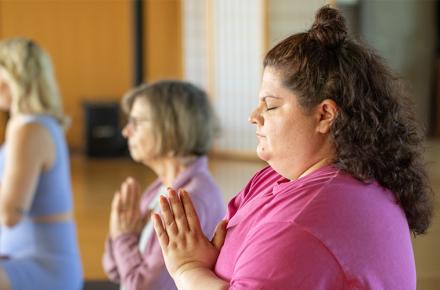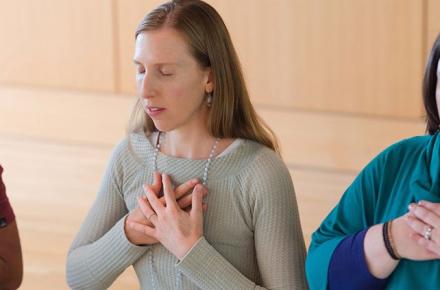Discernment: What Is Real?

Sometimes what we think we know prevents us from seeing clearly. We all have a frame of reference, a way we interpret information from the world around us, and it’s based on our past experiences, things we’ve been taught, and deeply ingrained beliefs about ourselves and other people. Sometimes self-deception is in play; there may be things we don’t want to see or accept. In order to exercise our power and our free will, in order to be accountable for the choices we make and the energy we spread, we have to be dealing with reality as it is, which is not always as we’d like it to be. Yogis call clear-seeing vidya. Avidya is one of the five kleshas, or obstacles to our freedom, and it means “ignorance of self, others and/or the world around us.” The practice of yoga is a process of examining what is real and what is unreal, what is authentic to us, and what we need to unlearn so we can see clearly.
Years ago, not long after I’d moved to Los Angeles, I took over the regular classes of a very popular teacher at a busy gym in West Hollywood. The other teacher had moved back East, and I knew a lot of his students were bummed out, so I went in knowing that I’d have my work cut out for me. After a few weeks of dealing with that understandable “I’m not sure I’m gonna like this” energy, things were good and the vibe in the room was awesome. We were having fun. People were focusing and breathing and sweating and laughing. We had a good thing going. Except for this one guy.
He always stood in the same place at the front of the room, and he was there like clockwork, three times a week. But he was hostile to me, frequently shot me dirty looks in class, and often shook his head at something I’d said. Sometimes he’d even roll his eyes. I wanted to talk to him about it, but he always arrived right before class and took off right after. I figured he was there because it was the only time slot that worked in his schedule.
Several months went by this way. I’d grown to accept that he didn’t like me, for whatever reason, but that he must have liked the class enough to deal with it. Then one day we bumped into each other outside the gym and I said hi to him. We had a short conversation on the way up to class, and although he was guarded, I was surprised that he was willing to talk at all. It was the first time I had sensed vulnerability underneath the layers of aggression, and it gave me a feeling of hope. He started showing up a little earlier, and he didn’t fly right out the door after class anymore. Whenever the opportunity presented itself, before or after class, I’d say hi and chat with him for a few minutes. He started talking to some of the other regulars, too. I grew to learn that he was a screenwriter who spent most of his time along with his laptop. One day he stayed after class, and when everyone had left, he asked if I’d like to meet him to go for a hike up Runyon Canyon. It felt meaningful to me, like it had taken a lot for him to ask, so I took my dog and met him there a few days later. We walked and talked for three hours. I learned a lot about his background, the struggles he’d been facing, his painful family history, and his successful battle against addiction.
Somewhere along the hike I started laughing and shaking my head. I told him I’d been convinced for the better part of the year that he pretty much detested me. His mouth fell open, and he told me that taking my class was the one thing that had gotten him through, that he’d been closed off emotionally for years and was finally starting to feel open again. I told him I’d been thrown off by the dirty looks and head shaking, and he said he’d been angry with himself. A lot of the things I’d been saying really resonated with him, and he’d been shaking his head at himself, not me. He looked at me that way because he felt like I was holding a giant mirror up to this face while keeping his feet to the flame, but he didn’t mean for it to seem like he was feeling angry or aggressive. Surprised was more like it, like when you pick up a drink thinking it’s tea, only to find out it’s apple cider vinegar.
I learned so much from this experience. I’d created an entire story in my head that wasn’t even close to reality. I’d interpreted his behavior through my own lens. My perception had been distorted by my own insecurities, fears, and doubts about what I had to offer and whether I was talking too much during class about the deeper healing aspects of the practice when maybe people just wanted a workout.
This guy followed me all over Los Angeles to take class. When I left the gym in West Hollywood and moved all my classes to Santa Monica, he drove down five times a week without batting an eye. For a while he was between cars and rode his bike back and forth, which was no small feat. Even though he has since moved away, he’ll surprise me and show up in class once in a blue moon when he’s in town, with a big smile, hugs, and lots of love. He’s my oldest regular, this guy who I thought couldn’t stand my guts.
We all fill in the blanks and construct our own versions of stories. Someone says something or does something, and we assume it must mean the same thing it would if we said that or did that, but that’s nuts. The only way you’ll ever know for sure where someone is coming from, what’s going on within them or how they’re feeling, is if you ask them directly and they decide to tell you. Human beings are such complex, vulnerable, deeply alone creatures in many ways. We spend most of our time with our internal dialogue, interpreting data form the outside world through our own filters and lenses—lenses that have been shaped and informed by our experiences by our beliefs, or by the things we think we should believe; by things we’ve been taught and things we’ve come to understand culturally. The lenses are so different that assuming you’re seeing what someone else is seeing is dangerous at best.
When people are in darkness and pain, they’re going to spread that—not intentionally, but just because that’s what is within them at that time. If you cross paths with someone who is in the midst of a painful transformation, it’s likely that there’s going to be some spillover into your life. It’s not personal, thought you may have to do some work around it, assuming it’s someone you want in your life. That may mean you need clear boundaries. Honest communication is always key, but writing a story in your head about why things are happening the way they are and creating dialogue, motivations, and character arcs for you and the other person is really only okay if you’re writing fiction.
We waste a lot of energy responding to imagined slights or aggression we’re creating ourselves. I know so many people who don’t bother having conversations because they “already know what the other person will say.” It takes courage to make yourself vulnerable, to admit you don’t know, to drop the stance where you get to be the victim or the hero or the persecutor and just be you, a human being who has enough work to do just to understand yourself in every moment. Clear seeing helps us shift the question form “Why does this keep happening to me” to “What can I learn from this pattern that keeps showing up in my life?”
There’s an excellent Aesop’s fable about this very thing that always comforts me when someone does or says something hurtful and I feel myself falling into the trap of taking it personally. I’ll give you my own spin on this fable.
Once there was a scorpion on the side of a stream. A frog hopped by, and the scorpion called out to him, asking for a ride across. The frog, incredulous, said, “Dude, you’re a scorpion. If I give you a ride, you’ll sting me.” And the scorpion said, “If I sting you, we both die.” This made sense to the frog, so he agreed to give him a lift. Halfway across the stream, the scorpion stung the frog. With his dying breaths, the frog asked, “Why have you done this to us?!” And the scorpion said, “Dude, I’m a scorpion.”
People can only be where they are and they can only have the tools they have. If a person treats us with disrespect or behaves in a way that’s cruel or dismissive, it’s no reflection of anything lacking within us; it’s a reflection of where that person happens to be at the moment in time when our paths crossed.
We also have to take the same honest but compassionate look at ourselves. Sometimes we don’t want to face what we’re doing, how we might be engaging in self-sabotaging behavior, and that isn’t always comfortable. But part of clear seeing means we’re getting hungry for the truth. When I say the “truth,” I don’t mean there’s one truth for everyone. It’s about getting hungry for your own truth, for the reality of your own experience, your own feelings. I know we’re taught to chase happiness, but when you sift that and decide to pursue what is actually happening rather than what you wish were happening, it’s such a relief. Instead of trying to control, manipulate, or cajole certain people or outcomes, you see, understand, and honor what’s in front of you. You can work with that—your own truth and whatever is true for those closest to you. It might break your heart, but at least you have some solid ground to stand on. That alone is comforting, and it puts you back in the power seat, because we’re never in control of other people or the things life puts in our path. Our power lies in our ability to choose our response to what we’re given.
One of the main things we’re trying to do in yoga, an in life, is just to see clearly. Yogis call this clear seeing vidya, and it has to do with our ability to discern what is real and what is unreal, what is permanent and what is impermanent. This power of discrimination is called viveka. That’s why we’ve begun by trying to bring to light anything that might be happening under the surface, so we can take a good look at it. If you want to be at peace, you have to be willing to take an unflinching but compassionate look at yourself first.
In the second chapter of the Yoga Sutras, Patanjali offers the keys to freedom. But before we can free ourselves, we have to identify what’s blocking us. Within this context, we learn about the five kleshas (obstacles). The first of these is avidya, which means ignorance of self and of life; it means we’re living in an unconscious fog. When we’re living this way, we’re looking at the world with blinders on. We see everything in relation to us, as if we are at the center of the universe and everything is happening to us, for us, or because of us. We’re having an egoic existence. Vidya is the process of taking off the blinders and experiencing life as though we are all connected and part of something much larger than any one of us.
Sometimes we have ideas (samskaras) about ourselves, or self-limiting beliefs, that are so old and so ingrained that they just play automatically in our thoughts and we don’t even think to question their validity. They may not even be our own; we may have internalized things that were said to us. Sometimes people carry around ideas like “I never get any breaks,” “No one likes me,” or “You can’t trust anyone.” When we have powerful false assumptions about ourselves or other people or about life in general, that’s going to affect the way we move through the world, the way we interact with people, the way we interpret data through our own lens. So we want to wipe the lens clean. We want to make sure that our attachment to our ideas or opinions is not distorting the lens through which we perceive other people, circumstances, or the world at large.
Find out about Ally Hamilton’s Kripalu program, Yoga’s Healing Power.
Excerpted with permission from Yoga’s Healing Power: Looking Inward for Change, Growth & Peace, © 2016 by Ally Hamilton.

















































